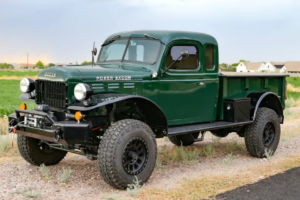This 1947 Dodge Power Wagon was acquired as a project out of Southern California by the seller in 2017 and subsequently underwent a multi-year refurbishment. Work included strengthening the frame, extending the cab, repairing areas of rust, fabricating a custom bed, and repainting the truck in green and black as well as installing a 2.8-liter Cummins turbodiesel inline-four, a Jeep AX-15 five-speed manual transmission, an NP231 dual-range transfer case, a Dana 50 front axle, a Sterling rear axle, 3.73:1 axle ratios, and four-wheel disc brakes. Additional equipment includes a front winch, side steps, 17″ Method wheels, power steering, AutoMeter instrumentation, a Murphy PowerView gauge, a reversing camera, leather-trimmed seats, wood door pulls, Vintage Air climate control, and an Alpine digital touchscreen display. This modified WDX Power Wagon is now offered with component manuals, partial service records, refurbishment photos, leftover green paint, and a clean Arizona title in the seller’s name.

Bodywork performed under current ownership included lengthening the cab by 12″ and adding rear quarter windows, patching the lower rear section of the cab, repairing rusted sections of the doors, refurbishing the door hinges, and fabricating a custom bed. Further work involved repainting the cab, bed, hood, and cowl in green and the fenders in black. A fabricated front bumper anchors a Rugged Ridge 12,500-pound electric winch with roller fairleads, the controller for which resides in a storage box on the left side of the vehicle. Additional exterior details include diamond-plate running boards and side steps, dual convex side mirrors, a split windshield, electric windshield wipers, tinted glass, front and rear turn signals, a reversing camera, and a receiver hitch. A high-lift jack is stored on the right-side running board. Noted flaws include cracked and split paint on the cowl at the base of the windshield as well as orange peel on the hood, on the roof, and on the bed. The seller states that the passenger door clunks when fully opened.

Black 17″ Method beadlock-style wheels are mounted with 255/85 Mickey Thompson Baja Boss tires; a non-matching spare tire on a Ford steel wheel is included in the sale along with Method wheel-center caps that have not been installed. The truck is equipped with power steering, and brake and suspension modifications are said to include the following components, many of which came from a 2001 Ford F-250 4×4:

Ford-sourced two-piston front brake calipers and single-piston rear calipers
Ford-sourced foot-operated parking brake
Chevrolet Corvette–sourced vacuum-assisted dual-circuit brake primary cylinder
Wilwood brake-proportioning valve
AGR Performance Rock Ram power steering
Saginaw steering gearbox
Cummins power-steering pump
Replacement front leaf springs
Ford-sourced rear leaf springs
Ford-sourced front anti-roll bar
Manually locking front hubs
The custom bed contains eight stake pockets, was constructed using 16-gauge steel, and is mounted to the frame with urethane bushings. The bed interior is sprayed with a Raptor epoxy liner, and the bed flooring is ¾”-thick varnished red oak.


The cabin was refreshed under current ownership and features an adjustable split bench seat trimmed in tan leather upholstery accompanied by color-coordinated door panels and contrasting carpeting. Appointments include a body-color metal dashboard, black-painted trim, wood door pulls, door locks, manual windows, a 2000-watt power inverter, interior lights, a trailer-brake controller, shoulder belts, a Vintage Air climate-control system, an Alpine digital touchscreen display, aftermarket speakers, and a USB cable mounted inside the glove compartment. Further modifications are said to include a reduced-size center-tunnel, a drive-by-wire throttle pedal, and under-seat and over-head storage compartments. The crank-open windshield and the windshield cowl vent were eliminated during the refurbishment. The seller notes that the windshield leaks during periods of heavy rain, orange peel is evident on the dashboard, the headliner is loose near the rear quarter windows, a ¼” by 4″ headliner patch piece is present above the rear window, and the windshield wipers do not return to their retracted position when switched off.


A woodgrain Grant steering wheel fronts AutoMeter instrumentation that includes a 120-mph speedometer and a combination gauge with readouts for fuel level, oil pressure, coolant temperature, and voltage. The steering column reportedly came from a 1965 Ford Mustang. A Murphy PowerView gauge is located to the left of the cluster. The seller notes that the engine “wait to start” indicator light illuminates on the Murphy gauge but not on the dashboard warning indicator.
